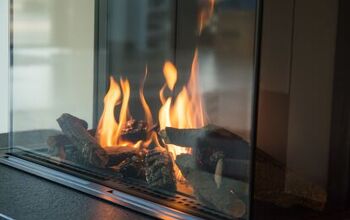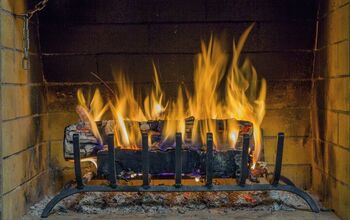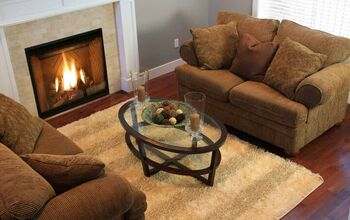How Much Gas Does A Fireplace Use? (Find Out Now!)

Fireplaces are one of the most popular ways to heat up a home and keep it looking stylish at the same time. If you have a gas fireplace that you have yet to use, you’re probably wondering what you should do and how much it’ll cost to keep it running. As it turns out, using a gas fireplace is remarkably affordable and efficient.
A gas fireplace uses 10,000-70,000 BTUs of gasoline per hour, and wood-burning gas fireplaces use up to 90,000 BTUs. You may use 1 gallon of gasoline per hour, or more, depending on the build and design of the fireplace. Gas fireplaces use less fuel than gas furnaces, and they are 60% cheaper to run.
Understanding how much gas your fireplace uses will make you appreciate gas fireplaces even more. Whether it’s just to cozy up for the winter or to actively heat your home, this guide will give you a good idea of what to expect in terms of heating bills, gas usage, and output.
How Can You Tell How Much Gas Your Fireplace Uses?
If you’re just installing your fireplace, then you can often find out by checking out your fireplace’s owner’s manual. If you have an older home and have a fireplace pre-installed, then you might be able to find out by looking at the data tag located on the bottom of your fireplace. Most fireplaces will use 30,000 BTUs per hour.
How Much Does It Cost To Use A Gas Fireplace?
Gas fireplaces never seem to go out of style, and part of the reason for that deals with their cheap price tag. A gas fireplace costs far less to operate than a wood fireplace, or even a typical furnace. This makes it a great choice for people who want to improve their energy bills.
On average, running a gas fireplace that consumes 30,000 BTUs per hour will cost 45 cents per hour to operate on full blast. A more realistic average hourly cost is closer to $0.12 to $0.19 per hour, simply because most people never operate their fireplace on the highest setting.
People who have low BTU fireplaces have it even better. If you have a low-powered natural gas fireplace, then you will be able to enjoy running your fireplace throughout your day for as little as $1.50 to $2.00. This makes it one of the most surprisingly cheap ways to heat a home on the market.
How Much Cheaper Is It To Use A Gas Fireplace Instead Of A Furnace?
If you have a gas fireplace, you might want to make it your primary source of heat during the winter. A typical furnace will cost between $1.12 to $1.50 per hour to run at the same rate as your gas fireplace. This makes your gas fireplace a full 60 percent cheaper than using a furnace.
Are Wood Fireplaces Cheaper To Operate Than Gas Fireplaces?
Though wood fireplaces are cheaper to install, they’re fairly pricey to operate when compared to a gas fireplace. A gas fireplace will cost around $65 to operate annually, while a wood fireplace will cost $195. That being said, many people are able to save money on wood by simply collecting firewood from their backyards.
Why Are Gas Fireplaces So Fuel Efficient?
If there’s one thing that we can all agree on, it’s that gas fireplaces are great for people who love energy efficiency. The biggest reason for gas fireplaces’ efficiency deals with the way they burn fuel. Natural gas is what scientists call a “complete burn,” in the sense that it doesn’t create soot and doesn’t have by-products in its combustion.
Moreover, the heat that is generated from a gas fireplace is designed to stay in your home. A typical vented fireplace will be able to keep up to 70 percent of its heat inside the room it’s heating. If you have a vent-free gas fireplace, around 99 percent of all its heat will remain in the room.
Can You Burn Wood In A Gas Fireplace?
A common misconception fireplace newbies have deals with fuel usage. Some people believe that gas fireplaces can burn wood if necessary, and even tout it as a way to save money on natural gas. This just isn’t true. Gas fireplaces are not built to burn wood and will become a fire hazard if wood is placed inside them.
Most people who have this belief mistook the faux wood racks that some fireplaces have as real wood. If you enjoy the aesthetics of wood-burning over a fire, then you might want to get a gas fireplace rack that has a wood-like appearance. This will give you the rustic look you want without potentially lighting your house on fire.
How Can You Make A Gas Fireplace More Efficient?
If you are trying to maximize the heat that gas fireplaces afford your home, then you may need to use a little strategy. These tips below will help you maximize your fireplace’s efficiency and improve your overall home quality:
- Switch to a ventless design. Though vented fireplaces are safer than vent-free designs, they also happen to be less efficient. If efficiency is your number one focus, switching to a ventless design will help maximize the heat you get for the money you pay.
- Keep your gas fireplace clean. Everything from the pilot light to the sensors in your fireplace will play a role in how well your fireplace is able to burn gas. Bad sensors can cause your fireplace to burn excess energy, while clogged piping can lead to excessive gas usage while maintaining a weak flame.
- Check to see if you can get a more energy-efficient model. It’s true. Energy-efficient fireplaces are now becoming a thing, and they’re there to help you save extra money on energy bills. If you have a very old gas fireplace, getting a fuel-efficient model, or even getting a smaller fireplace can be a smart move.
- Open your fireplace’s damper as wide as possible when you first start. This helps maximize the airflow your fire will receive, making it easier for the fire to burn fast and cleanly when it first ignites. While this is mostly a wood fireplace tip, it can still work with some gas models.
- Add a fireplace insert to your setup. This is a fast way to ensure that you get heat blowing into your room and also improve your overall safety.
- Get a fireplace heater. A fireplace heater is a device that helps circulate extra heat from your fireplace to the rest of your room, boosting your fireplace’s efficiency.
- If you don’t have them already, add glass doors. Your glass doors will work together with your damper to help maximize the heat you get from your fireplace. Glass doors will prevent cold air from getting forced into your room. However, you should always check to see if your fireplace is compatible with door designs first.
Related Questions
Do you need a chimney in order to get a gas fireplace?
While a chimney would be ideal in many cases, you don’t always need one in order to install a gas fireplace. You can use vent-free fireplace models in almost any room in your home, making it possible to enjoy a fireplace without a new chimney installation. Another option that you can look into is a tabletop fireplace, which is more an aesthetic booster than it is a heating method.
Can you safely install a gas fireplace on an inside wall?
Gas fireplaces used to be dangerous if installed in the wrong area, but that’s no longer the case. Modern gas fireplaces can be installed anywhere that there is a gas connection, and that includes your inside walls. However, there is a little caveat here. While you can add a fireplace anywhere, it’s best to make sure you get the right type of fireplace for your connection and chimney setup.
Should you use gas fire or central heating to heat your home affordably?
Though gas fires are highly efficient when it comes to the heat they provide, they are not the most efficient devices on the market. Central heating, when done with a high-efficiency boiler, will always be more efficient than a standard gas fireplace. If you want to save money, then going for a central heating system is your best bet.

Ossiana Tepfenhart is an expert writer, focusing on interior design and general home tips. Writing is her life, and it's what she does best. Her interests include art and real estate investments.
More by Ossiana Tepfenhart



























